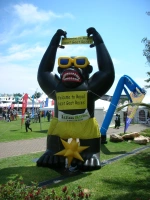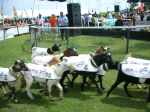When we walked down to the Munyunyo beach a few weeks ago, we saw a sign for an after-party for the goat races. Up until that point, I didn’t realize there was such a thing as goat races, but I wasn’t particularly considering going. Then, Terra forwarded a flier she had received describing the event – The Royal Ascot Goat Races. I’ve spent enough time in England and read enough Dick Francis to know about the “real” Royal Ascot Race (which is for horses, not goats). This instantiation, for charity, suddenly looked more interesting. So, we all decided to go.
First, let’s cover briefly the history of the Royal Ascot races. Racing first took place at Ascot in Berkshire 1711, after then Queen Anne decided that racing should be held on the spot not far from Windsor Castle, one of the royal residences. Racing was ensured to continue there by an act of parliament in 1813. The first running of what has now become the Royal Ascot event arguably took place in 1807.
One of the more notable aspects of the Royal Ascot races has nothing to do with horses, but with dress. The Royal Enclosure has a very strict dress code, including dresses of appropriate length and straps with hats or fascinators for women and “black or grey morning dress, including a waist coat and top hat” for the gentleman (from the Royal Ascot web site here: http://www.ascot.co.uk/royal/royalenc_dress.html). There are specific places that men are allowed to remove their top hat; otherwise, it must remain on. Any violation of the dress code can get you expelled from the encolusre. In case you don’t know (I didn’t), a fascinator can be informally defined as bizarre head wear with feathers, lace and other materials, worn by women in place of a hat to fancy events where they want to get noticed. Given this tradition, it isn’t surprising that the Royal Ascot Goat Races had a costume competition.
Since traffic going from Kololo in central Kampala to Munyunyo, which is more like “the suburbs”, is often bad on weekends, we took the back way. It was a bit difficult, since five of us were in a car that doesn’t have good clearance at the best of times, and the roads along the back way were in pretty bad shape. We considered getting out a few times to save the shocks and the under-carriage but the car survived the journey.
We had heard from one of our standard taxi drivers that the festivities started at 8am, but we were not going to get up that early. It’s good we didn’t, as the doors didn’t even open until early afternoon. We got there around 2pm, just in time for the second race. The security was very tight, including making people get out of their cars so that the cars can be searched separately, bag searches, and metal detectors. Given the number of people there, the level of security made sense, as the threat from Al-Shabab still exists. There was actually a wedding going on that day also at the Speke Resort, where the races were held. We saw the bridal party come in, complete with bride in bridal gown and the bridesmaids in their long gowns. They fit right in actually, among those who dressed for the event. My party was primarily in jeans/shorts and t-shirts, although we did have 3 (quite normal) hats in our group. At the entrance to the races themselves, we were greeted by this:
The races themselves were run about every 45 minutes. There was a standard enclosure in the center with the (mostly English sounding) emcees calling the races. There were about 10 goats in the two races we saw. Companies like Ericsson sponsor the prize money for the races (and the proceeds all go to charity). The winner in the first race I saw (only the second of the day) won 2.8 million Ugandan shillings (about 1245 USD). I assume like most all day race events, the prize money goes up as the day goes on. So, the goats did an initial preview lap, so that the goats could get warmed up and the spectators could make their final selections (yes, there was a tote for bets). The goats each had a handler using a long lead rope.
When the race itself begins, the goats take off in a clump. There’s a padded slide behind them to keep them moving, as they often seemed more interested in grazing or fighting than racing. Often they tried to go the wrong way, so the prod was useful in keeping the race moving. The lead goat didn’t change much in the races I watched; I do not know if that is typical goat racing behavior. The prod tended to keep the goats in a pack, so the opportunity for the lead to change often was certainly there.
Our groups discussed the possibility of sponsoring a goat in next year’s race. Since I have no idea where I will be this time next year, I don’t know if that would be a sensible thing for me. However, the rest of the group is pretty well committed for at least another year – to Kampala, that is. I’m not so sure about their budding career in goat racing.
I am glad I had the chance to see this once, and to take at least some pictures. After all, how could one miss such a cultural and social event of the season? That said, I can’t say I have a burning desire to go again.


